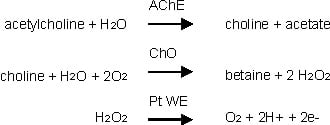Acetylcholine
Applies to
Electrochemical detector, application note 213_014
Summary
The analysis of Acetylcholine (ACh) is done using reversed phase HPLC separation followed by enzymatic conversion of ACh into H2O2 (hydrogen peroxide). The peroxide is detected using an electrochemical flow cell with platinum working electrode. This particular combination makes the ACh assay a difficult one.

The mobile phase is set at pH 8 to facilitate the enzymatic conversion. This puts some demands on the stability of the stationary phases of both columns. Some suppliers add a so-called pre-saturation column to the LC system to counteract bleeding of the analytical column and of the enzyme reactor. These slowly released contaminants adsorb on the working electrode. Also the enzyme activity will deteriorate in time. The surface of the platinum working electrode will slowly oxidise resulting in a drifting baseline and loss of sensitivity.
Remedy
Polishing of the working electrode is required at least 2 times a week. The enzyme column as well as the analytical column have to be replaced regularly. A small (but continuously) drift in baseline is considered to be normal.